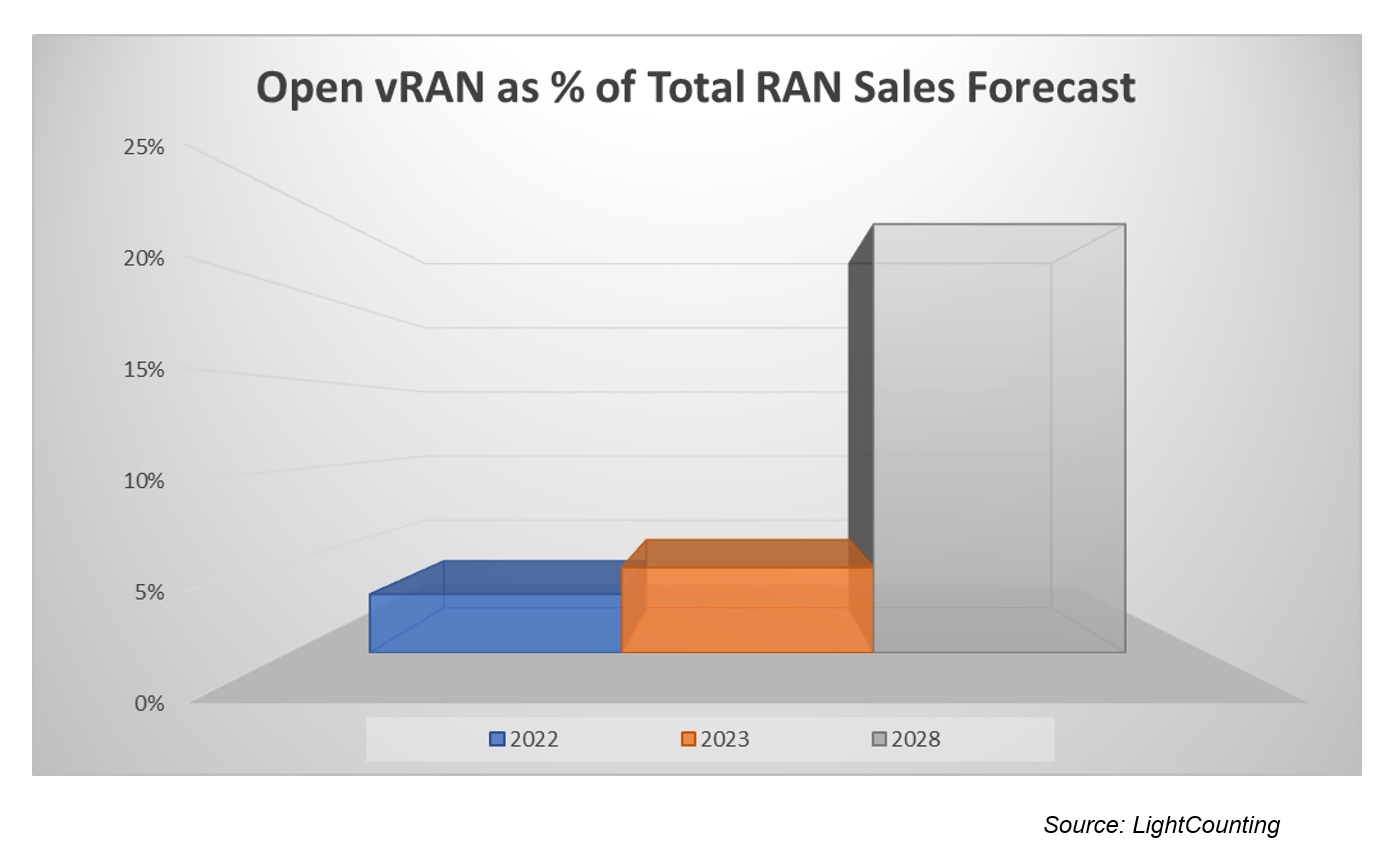Month: March 2023
Global Cloud VPN Market Report: Rising Demand for Cloud-based Security Services
The Global Cloud Virtual Private Network (VPN) Market Size, Share, Trends, Product Type (Services and Software), Connectivity Type (Site-To-Site and Remote Access), Company Size, End-user, and Region – Forecast to 2030 report has been published by ResearchAndMarkets.com.
The global cloud Virtual Private Network (VPN) market is expected to experience rapid growth in the coming years, with an estimated market size of USD 40.78 Billion by 2030 and a projected revenue compound annual growth rate (CAGR) of 21.6%.
This growth can be attributed to various factors, including the increased demand for cloud VPN technologies in security products and services, the rising adoption of secure remote access, and the growing acceptance of private clouds.

Cloud VPNs are becoming increasingly popular among businesses due to their ability to provide high security without sacrificing usability. They are cost-effective and easy to set up, and provide secure, encrypted web browsing capabilities. Compared to traditional VPNs, the new generation of cloud-based VPNs offers more flexibility, cost efficiency, and security features. This makes them ideal for businesses that regularly share sensitive or confidential information over private networks.
Cloud VPNs protect against both internal and external threats, and offer faster access to applications, ensuring smooth business operations. Major tech companies are investing in cloud VPN-based services, which is contributing significantly to market revenue growth. For example, GoodAccess recently secured a $1 million seed funding round to expand its cloud-based VPN services. Similarly, HMD Global, the manufacturer of Nokia smartphones, has partnered with ExpressVPN to offer secure digital connections on mobile devices using 3G, 4G, and 5G networks.
Market Dynamics
The market for cloud VPN services is expected to grow due to the increased adoption of secure remote access and the widespread acceptance of private clouds. Leading cloud VPN service providers are focusing on replacing traditional VPNs with cloud VPNs to meet the growing demand for more secure and sophisticated technologies that support privacy protection in a reliable and streamlined manner. Businesses that have already adopted cloud services have seen significant improvements in process efficiency, time to market, and IT spending reduction.
Cloud computing investment is expected to reach $160 billion worldwide by 2020, nearly twice what it was in 2017, and cloud solutions are expected to account for 80% of all IT investments by 2019. Cloud VPNs enable secure connections between offices located anywhere in the world over an open network and can connect any number of branch offices with the main office, supply chain, and partners. The VPN technology also enables user-to-office connections, making remote working simple.
The revenue growth in this industry is driven by an increase in product launches by leading tech companies that target secure remote access and widespread acceptance of cloud computing. For instance, Google has released BeyondCorp Remote Access, a zero-trust remote-access service that allows remote teams to access their companies’ internal web-based services without the use of a VPN.
The use of VPNs is restrained by stringent government regulations, which limit the growth potential of the market. Governments worldwide have implemented severe restrictions and regulations against using VPNs to prevent criminal use and increase the visibility of online activity. Cybercriminals can use VPNs to conceal their illegal activity and maintain their anonymity. New regulations mandate that all VPN service providers keep customer data for at least five years.
For example, India has approved a law requiring all VPN service providers to retain user data, including names, email addresses, phone numbers, and IP addresses, for at least five years. These regulations are focused on strict VPN regulations, and the national order mandates the collection of specific, substantial customer data even after users delete their accounts or cancel their subscriptions. These regulations apply not only to VPN providers but also to cloud service providers, data centers, and cryptocurrency exchanges.
Product Type Insights
The global Cloud Virtual Private Network (VPN) market is divided into two product types: software and services. In 2021, services dominated the market, with Managed Security Service Providers (MSSPs), Virtual Private Network as a Service (VPNaaS), and cloud-based remote access being some of the frequently used services. The need for managed cloud VPN-as-a-service solutions has risen as businesses require secure and remote connections to their corporate network through the Internet.
Additionally, cloud-based services have gained popularity among businesses as they offer cost-effectiveness. On the other hand, the software segment is predicted to experience rapid growth during the forecast period. Many businesses have realized that using a VPN provides an extra layer of protection and privacy for their remote workers. Cloud-based VPN software allows users to access systems through an internet-based software deployment approach. This eliminates the need for businesses to maintain physical servers or infrastructure.
Connectivity Type Insights
The global Cloud Virtual Private Network (VPN) market is also segmented based on connectivity type: site-to-site and remote access. Site-to-site VPNs held the largest revenue share in 2021 due to their secure IPsec protocols that encrypt communication transmitted through the VPN tunnel. They are used to establish encrypted links between VPN gateways located at different geographical sites, which require secure inter-site communication.
The site-to-site VPN tunnel also prevents any attempts to intercept traffic from the outside. Recent innovations in site-to-site VPN services, such as IPSec VPN connections through Direct Connect, are driving revenue growth of this segment. On the other hand, remote access VPNs are predicted to grow at a steady rate during the forecast period. The coronavirus pandemic has led to the increased popularity of remote access VPNs, allowing remote employees to connect safely to company networks. Cloud-based solutions are preferred to control costs, and major tech companies are launching innovative remote VPN solutions to drive revenue growth of this segment.
End-User Insights
Based on end-users, the telecom and IT sector held the largest revenue share in 2021. New demands for fast and secure VPN networks by the telecom industry have led to the growth of cloud VPNs. Operators and vendors in the telecom industry are adopting cloud-native technologies, while public cloud and IT companies have been using them for some time. Cloud-based VPNs have experienced tremendous growth over the past five years, leading to a rise in global spending on cloud computing. Cloud VPNs offer virtual private branch exchange capabilities, improving employee accessibility while maintaining cost management.
Regional Insights
In terms of regional analysis, the Cloud Virtual Private Network (VPN) market in North America has dominated the global market in 2021 with the highest revenue share. This can be attributed to the increasing partnerships between major companies and government agencies to address data protection and privacy issues. Furthermore, the presence of leading market players in the region has been a driving factor for market growth. For example, Google, a subsidiary of Alphabet Inc., has announced its plans to launch a VPN service for its users that will be bundled with certain Google One subscription levels. The VPN service has been introduced in the United States in 2020 for Android users through the Google One app, with plans to expand to other nations and operating systems such as iOS, Windows, and Mac.
Europe is anticipated to experience steady revenue growth during the forecast period. According to NordLayer’s Global Remote Work Index, Germany is the top country for remote work followed by Denmark, the USA, Spain, Lithuania, the Netherlands, Sweden, Estonia, Singapore, and France. Consequently, there has been a rising demand for privacy protection, and businesses are choosing cloud-based solutions to provide their remote access to Virtual Private Networks to efficiently manage costs. Major IT companies are releasing their own advanced remote VPN solutions, which is driving revenue growth in the region. For instance, Deutsche Telekom has launched a cloud VPN service for small and medium-sized organizations in Croatia, Hungary, and Slovakia, providing easy access to highly secure and scalable internet services. The cloud VPN option includes cloud-managed IT solutions, firewalls, online protection, and remote access through encrypted VPNs. Additionally, Cisco and Deutsche Telekom are collaborating on this project.
About ResearchAndMarkets.com:
ResearchAndMarkets.com is the world’s leading source for international market research reports and market data. We provide you with the latest data on international and regional markets, key industries, the top companies, new products and the latest trends.
References:
MTN and Microsoft Azure accelerate Africa’s digital transformation via the public cloud
South Africa-based network operator MTN has joined the growing list of telcos that are making the move to public cloud. Following the signing of a five-year strategic partnership in September 2022, MTN and Microsoft are in the process of delivering a program of work that will see the latest technologies deployed for the benefit of MTN’s customers, starting with South Africa and Nigeria.
The company announced it has embarked on a program of work to migrate various back end systems to Microsoft Azure. It is called Project Nephos, and its principle aim is to deliver maximum value as early as possible by identifying the workloads most suited to being redeployed on Azure. It’s initiating the project by transferring the BSS and OSS applications used by MTN’s opcos in South Africa and Nigeria. This approach has already enabled MTN to complete a proof of concept for the world’s first 5G standalone core network solution deployed in Microsoft’s Azure public cloud in just a few weeks!
Under the program, MTN will also migrate EVA, its core big data platform. In addition to putting it existing workloads on Azure, MTN also plans to leverage its capabilities in AI and machine learning to come up with new use cases that, in MTN’s own words, “bridge typical divides across network, IT and commercial domains.”
MTN and Microsoft have hired Accenture to provide technology implementation, integration and support services in hopes of making the whole thing go smoothly. They have also launched a staff training program that covers cloud technologies, devsecops (development, security, and operations), and data management.

MTN and Microsoft first announced they were working together in November last year. Their five-year strategic partnership centres on transforming and modernising MTN’s comms and technology infrastructure, and building what MTN hopes will be the largest and most valuable platform business with a clear focus on Africa.
Given MTN’s scale – it serves more than 270 million subscribers across 19 markets in Africa and the Middle East – it is a pretty big deal. It has echoes of Dish deploying its greenfield 5G network on Amazon Web Services (AWS), or AT&T announcing plans to move its 5G network onto Azure.
In addition to Monday’s OSS/BSS migration, MTN and Microsoft last week showed off what they claim to be the world’s first proof-of-concept (PoC) of a 5G standalone (SA) core network deployed on Microsoft Azure.
Every element, including the control plane, user plane and management nodes was fully deployed on Microsoft’s South Africa Azure Region, giving MTN a taste of what it can expect from a cloud-native 5G network, i.e., rapid deployment and scalability. These two capabilities are particularly important to MTN, which aims to reach 10-30% population coverage with its 5G network in the medium term.
“Our strategic partnership with Microsoft will enable us to transform the way we deliver products and services to our customers. We will bring the power of cloud computing to life, driving development and innovation with speed, flexibility and predictable investments and operations. We remain focused on nurturing the digital skills within MTN and in the societies we operate in, and building digital platforms to drive digital transformation across Africa and the Middle East,” said Nikos Angelopoulos, MTN Group’s CIO, in a statement.
“Harnessing the power of MTN, Microsoft and Accenture, we will be working closely together to build the next wave of compressed digital transformation across the continent. We see this program becoming a global standard in the industry for years to come” Nitesh Singh Communications, Media and Technology Lead for Accenture Africa.
References:
MTN and Microsoft accelerate Africa’s digital transformation in the public cloud
LightCounting: Open RAN/vRAN market is pausing and regrouping
Cisco 800G line card for Cisco 8000 Series Routers powered by Silicon One ASIC
Cisco today announced 800G innovations that continue to transform the economics and sustainability of the Internet for the Future, to help its customers connect the nearly 40% of the world’s population that remains unconnected or underserved.
As IoT devices grow from billions to trillions, demand for bandwidth grows not only from connecting devices with 5G and Wi-Fi, but also from the AI/ML workloads required to drive insights from IoT. Applications such as generative AI, search, language processing, and recommendation engines, are driving rapid growth of AI/ML clusters in data center environments that require more bandwidth over traditional workloads. AI/ML fabrics need to scale with denser spines that are critical to support the massive number of processors with low latency, in addition to capacity expansion in Data Center Interconnect.
While bandwidth growth seems unlimited, space and power are limited. Dense and power-efficient platforms are required. Cisco is doubling the capacities of communication service provider and Webscale customer backbones, metro core, and data center networks compared to 400G/100G modular solutions.
The new 28.8Tbps / 36 x 800G line card for Cisco 8000 Series Routers is powered by Cisco Silicon One [1] and lowers operational costs while protecting investments as communication service providers and cloud operators transform networks from 100G to 400G, and 800G capacities. Customers can benefit from carbon savings by using less hardware to scale, and equipment reuse.
Note 1. Cisco Silicon One is claimed to be the only unifying architecture enabling customers to deploy the best-of-breed silicon from Top of Rack (TOR) switches all the way through the web scale data centers and across the service provider networks with a fully unified routing and switching portfolio.
“We continue to expand 800G to more use cases, from AI/ML fabrics to the core, to help our customers meet their performance and sustainability goals,” said Kevin Wollenweber, Senior Vice President and General Manager, Cisco Networking, Data Center and Provider Connectivity. “With our dense core and spine solutions using new double density line cards with Cisco Silicon One, we have accelerated the transition to 800G anywhere.”
Key Benefits of Modular Cisco 8000 Series Router Systems Powered by Cisco Silicon One P100:
- Economics: With up to 83% space savings, customers can build denser networks using much of the same infrastructure to support use cases such as 5G, IoT, broadband and AI/ML. Other benefits include:
- By doubling the capacity in the same chassis footprint, the Cisco 8000 Series Router platform has up to twice the space efficiency over 400G single chassis systems.
- These 800G single chassis systems can now support equivalent traffic loads with up to 6x more space efficiency compared to current 400G distributed chassis solutions, by delivering up to 15 Tbps per Rack Unit.
- New 800G modular systems can also provide the equivalent bandwidth capacity with up to an estimated 68% savings in power compared to 400G solutions to help reduce operational costs.
- Sustainability: With up to 68% power savings, the 800G systems can help customers meet their sustainability goals.
- Assuming a single 800G system is in use 24 hours per day, 365 days per year, the potential energy savings over 400G systems would reduce GHG emissions by up to 215,838 CO2e per year.
- This amount of carbon savings is estimated to be equivalent to reducing carbon emissions from charging 40 million smartphones or burning 366,923 pounds of coal a year [1]
- Customers can also reuse common equipment when upgrading to 800G systems to help cut down on e-waste.
- Architectural Innovations: Powered by Cisco Silicon One P100 ASICs and Cisco pluggable optics, the new line card offers massive throughput for Cisco 8800 Series modular systems. Key features include:
- Advanced 100G SerDes technology allows customers to double current 400G port densities and increase by 8-fold current 100G port densities in the same form factor, supporting 72 x 400G and 288 x 100G ports per slot.
- Ability to scale up to 800G to support increasing traffic demands with four, eight, twelve, and 18-slot chassis. Customers can scale up to 518 Tbps capacity with a single 18-slot modular 800G system.
- Pay-as-you-grow Flexible Consumption Model helps customers futureproof their deployments by right-sizing the network, adding capacity over time to better align to business outcomes.
- Cisco’s new generation of pluggable optics provide investment protection through backwards compatibility with existing QSFP pluggable transceivers.
- Operational Simplicity: With advanced visualization dashboards, services monitoring with actionable insights, and closed-loop network optimization customers can detect issues and troubleshoot faster.
- With the latest enhancements in Crosswork Network Automation the speed at which network elements and services can be added has been significantly improved.
- New IOS XR Path Tracing provides hop-by-hop visibility of the packet’s path through the network.
Industry Response:
“Based on our extensive market research and traffic analysis, we are forecasting continued growth in data traffic with fixed and mobile services, including for 5G, broadband, IoT and cloud. These trends are putting networks under increasing pressure, which is why scaling to 800G throughput in the future with solutions such as Cisco 8000 will be in demand, while helping service providers and cloud providers improve operational efficiency, sustainability, and user experience.” — Simon Sherrington, Research Director, Analysys Mason
“Together with Cisco, we seek new approaches to drive market differentiation and deliver business outcomes through agile, secure infrastructure at every stage of the technology journey. As a key enabler of the kingdom’s Vision 2030, we must ensure that our technology stays at the forefront of technological Innovations. With modular 800G innovations and Silicon One P100 on the Cisco 8000 Series, we continue to push towards new levels of cloud connectivity and digital transformation while benefiting from operational efficiencies that allow stc group to maintain providing a high-performing, lower cost-per-bit service to our customers.” — Bader Allhieb – stc Infrastructure, stc
“Colt is working towards ESG By Design, which means our firm commitment to sustainability spans every part of our business. It’s imperative that we work with partners that share our values and strive to build a better, cleaner planet. Cisco’s latest routing innovation shows its dedication to finding powerful and effective ways of scaling capacity, whilst mitigating the environmental impact. It marks an exciting next stage in the future of sustainable digital infrastructure.” — Kelsey Hopkinson, VP-ESG, Colt Technology Services
“With the implementation of Florida LambdaRail’s new FLRnet4 400G backbone, space becomes one of our primary concerns as we had exhausted our existing footprint in many of our sites. The combination of unbelievable forwarding capacity, operational efficiency, and the dependable IOS XR network operating system made the Cisco 8000 Series the obvious choice for our new network. We couldn’t be more pleased with our choice. We not only have a state-of-the-art network, but the Cisco 8000 series solution ensures there is enough opex savings to scale our network for years to come.” — Chris Griffin, Chief Network Architect, Florida LambdaRail
Supporting Resources:
- Read the Blog: Scaling the Internet for the Future with 800G Innovation, by Satish Surapaneni
- https://blogs.cisco.com/sp/scaling-the-internet-for-the-future-with-800g-innovationsMass-Scale Infrastructure for Core
- Cisco 8000 Series
- Cisco Silicon One
- Cisco Optics
- Crosswork Network Automation
- Cisco IOS XR Path Tracing
References:
Comcast Xfinity Communities Wi-Fi vs Charter’s Advanced Wi-Fi for Spectrum Business customers
Comcast has about 22 million Wi-Fi hotspots which are available free of charge for its Comcast Business and Xfinity customers (including this author who has used their WiFi hotspots in Santa Clara, CA and Pacifica, CA).
Xfinity Communities serves about 250,000 properties from multi-dwelling units (MDUs) to single-family communities, assisted living residences, hospitals and college dormitories. Xfinity Communities has six special account managers to handle its top 40-50 largest property owners. Some of the properties it serves are spread out so the company is providing Wi-Fi not just to specific units but also in the lobbies, on the grounds and at the pool, etc.
Although Comcast has the technology to provide Wi-Fi to a whole building without wiring multiple individual units, it seems to prefer the more traditional model. “To serve individuals best you need some kind of wired technology,” said Mike Mancini, director of sales engineering for Xfinity Communities. “Every unit gets wired to make sure we can deliver the highest speeds possible,” he added.
Xfinity Communities can and does wire the dormitory building, but not every individual unit. “We do hook up entire buildings as well, and people don’t have gateways, they have an access point up on the wall. We can provide connectivity both ways, it really depends on the property. We’re very flexible,” Mancini said.
Xfinity Communities serves selected apartment buildings. With pre-installed xFi Gateways in every unit, residents get instant access to WiFi after moving in. They can sign up for Xfinity Internet upon arrival, lease the xFi Gateway, and get connected on the spot — all from the provider of the largest gig-speed network.
……………………………………………………………………………………………………………………………………………………………………………………………………………..
Separately, Charter Communications this week announced the availability of its Advanced Wi-Fi for Spectrum Business customers across its 41-state footprint. Charter’s Advanced Wi-Fi includes its Red Dot Design router, which can support up to 200 devices simultaneously. And it includes greater coverage with Spectrum Wi-Fi Pods, which are additional access points for extended Wi-Fi coverage and more consistent speed to all corners of the business.
“Small businesses rely on technology, specifically the Internet and WiFi, to compete in today’s marketplace,” said Dave Rodrian, Group Vice President, WiFi Products, for Charter. “Now, with the launch of Advanced WiFi throughout our footprint, we can offer small and medium-sized businesses faster and more secure WiFi connections, giving them additional control over their network so they can improve their efficiency and productivity.”
More information about Advanced WiFi and other Spectrum Business connectivity services is available here.
References:
https://www.xfinity.com/multifamily
https://www.fiercewireless.com/wireless/comcast-touts-its-xfinity-communities-wi-fi
https://corporate.charter.com/newsroom/advanced-wifi-available-to-spectrum-business-customers
ABI Research: Major contributors to 3GPP; How 3GPP specs become standards
Three large network equipment vendors (Huawei, Ericsson, and Nokia) have been leading in both the number of contributions and approved contributions for 5G technologies to The 3rd Generation Partnership Project (3GPP). This is particularly the case with specifications related to User Equipment (UE) specifications and functionalities that are developed under RAN1, RAN2, RAN4, RAN5, SA2, SA3, and CT1 Working Groups (WGs).
Editor’s Note:
The 3GPP Organizational Partners (OP) are the seven Standards Developing Organizations (SDOs) – from China, Europe, India, Japan, Korea and the United States. The OPs are:
ARIB The Association of Radio Industries and Businesses, Japan
ATIS The Alliance for Telecommunications Industry Solutions, USA
CCSA China Communications Standards Association
ETSI The European Telecommunications Standards Institute
TSDSI Telecommunications Standards Development Society, India
TTA Telecommunications Technology Association, Korea
TTC Telecommunication Technology Committee, Japan
Participation in 3GPP is made possible by companies and organizations becoming Individual Members (IM) of one of the OPs.
- 3GPP specifications are not standards, they have no legal standing. They become “official” standards once one or more of the OPs transposes them, as ETSI has done many times.
- 3GPP specs become ITU-R recommendations when they are submitted to ITU-R WP5D by ATIS, discussed and agreed upon, then sent to WP5 plenary in November for final approval. That procedure was followed to create the ITU-R M.2150 recommendation which features 5G-NR.
……………………………………………………………………………………………………………………………………………………………………………………………………………….
The list of the most active companies within 5G 3GPP standards is listed in the table below:
| Top Ranked by Total Contributions | Approved Contributions | Total Contributions | Company Category |
| Huawei | 15,266 | 43,753 | Incumbent Infrastructure Vendor (End-to-End) |
| Ericsson | 11,601 | 36,375 | Incumbent Infrastructure Vendor (End-to-End) |
| Nokia | 7,553 | 23,112 | Incumbent Infrastructure Vendor (End-to-End) |
| Qualcomm | 5,523 | 18,471 | Chipset |
| Samsung | 3,548 | 16,464 | Incumbent Infrastructure Vendor (End-to-End) |
| ZTE | 3,415 | 15,291 | Incumbent Infrastructure Vendor (End-to-End) |
| Intel | 2,151 | 10,770 | Chipset |
| LGE | 1,396 | 10,139 | Handset/UE Vendor |
| CATT | 1,934 | 9,792 | Government/Institution/SDO/Academics |
| vivo | 1,205 | 8,367 | Handset/UE Vendor |
| MediaTek | 1,848 | 7,766 | Chipset |
Source: ABI Research

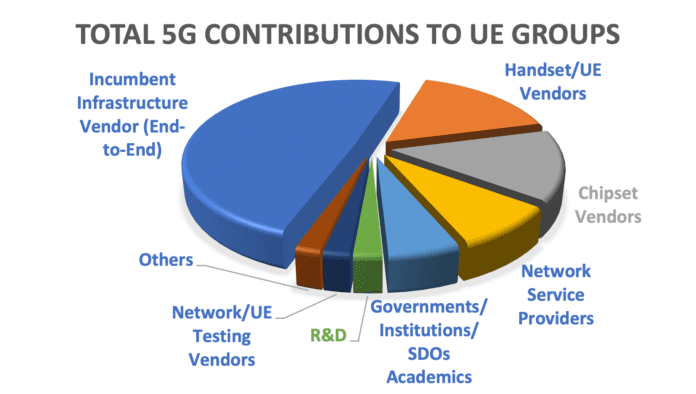
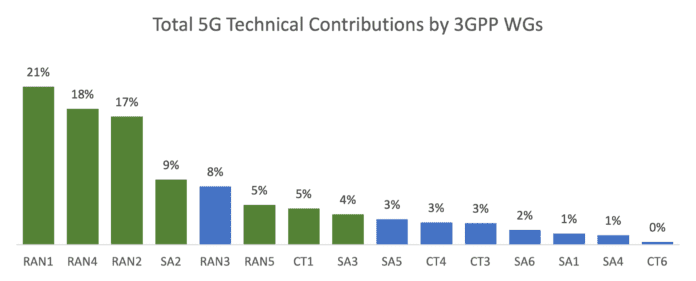
Key Takeaways:
- Counting contributions alone is insufficient to identify leaders in 3GPP standardization processes. However, it is a crucial step in recognizing active contributors and identifying innovation.
- More than 400 companies from the industry have participated in 3GPP standardization; however, only a handful of companies are consistently active in driving 3GPP 5G standards.
- Huawei, Ericsson, and Nokia have, so far, been leading in both the number of total and approved contributions for 5G technologies to 3GPP.
- Network infrastructure vendors are significantly more active than any other company categories, followed by handset vendors, chipset vendors, network service providers, and government research institutions.
- UE-related WGs (i.e., RAN1, RAN2, RAN4, RAN5, SA2, SA3, and CT1) take 80% of total contributions. RAN1, RAN2, RAN4, and SA2 are the most important WGs, impacting the entire mobile industry and receiving massive interest.
References:
https://www.3gpp.org/about-us/partners
ITU-R M.2150-1 (5G RAN standard) will include 3GPP Release 17 enhancements; future revisions by 2025
Busting a Myth: 3GPP Roadmap to true 5G (IMT 2020) vs AT&T “standards-based 5G” in Austin, TX
IBM Cloud and Wasabi partner to drive innovation across hybrid cloud environments
IBM and Wasabi Technologies today announced they are collaborating to drive data innovation across IBM hybrid cloud environments [1.]. This collaboration aims to allow enterprises to run applications across any environment – on-premises, in the cloud or at the edge – and help enable users to cost efficiently access and utilize key business data and analytics in real time. The Boston Red Sox will be the first to leverage the joint power of IBM Cloud Satellite® and Wasabi hot cloud storage, designed to improve the club’s operations across its entire business.
A hybrid cloud network architecture consists of private servers, public cloud virtual servers, and the network that connects them. Public cloud providers typically utilize direct MPLS or Ethernet connections to move data between the client’s private cloud and the service provider’s public cloud.
Note 1. IBM’s hybrid cloud provides a common platform across enterprise customers cloud, on-premises and edge environments. IBM says their hybrid cloud approach can offer up to 2.5x more value than a public cloud-only approach.
…………………………………………………………………………………………………………………………………………………………………….
Both IBM Cloud and Wasabi are committed to delivering resiliency, performance, security, and compliance capabilities for their clients. Wasabi hot cloud storage does not charge for egress or API requests when they want to access their data, which Wasabi reports can help with cost predictability and savings for clients. Data can be stored and accessed how and when it is needed. The hybrid cloud approach delivered with IBM Cloud Satellite, can help clients manage cloud object storage and workloads running across environments from a single control point, using innovative security and controls no matter where data is being collected, processed or shared. The Red Sox plan to leverage Wasabi hot cloud storage across its hybrid cloud infrastructure while piloting IBM Cloud Satellite to house data including player video, analytics, surveillance data, IoT, and more, across Fenway Park and bring the flexibility and agility of public cloud services to its secured on-premises data center.
“Our critical data is growing at an incredible rate, so our organization is prioritizing a cost-effective and scalable approach to leverage cloud technology,” said Brian Shield, senior vice president and chief technology officer, Boston Red Sox. “The performance and cost reliability Wasabi delivers have already been advantageous for the Red Sox, and with the addition of IBM hybrid cloud technology we hope to take our digital initiatives to the next level. All of that ultimately funnels back to delivering a best-in-class fan experience.”
Through IBM Cloud and Wasabi, clients across all industries can take advantage of extended secured and open cloud services to help transform applications and workflows, managing security across any environment. This allows enterprises to store and access their data whether on-premises, in the cloud or at the edge.
“Wasabi is on a mission to store all the world’s data. Organizations storing an enormous amount of data, including sports organizations, need to be able to store it in an affordable, accessible way without being locked into a single vendor with exorbitant fees,” said David Friend, co-founder and chief executive officer, Wasabi Technologies. “Collaborating with IBM demonstrates Wasabi’s commitment in the cloud storage market and gives our customers a better way of managing their data cross locations.”
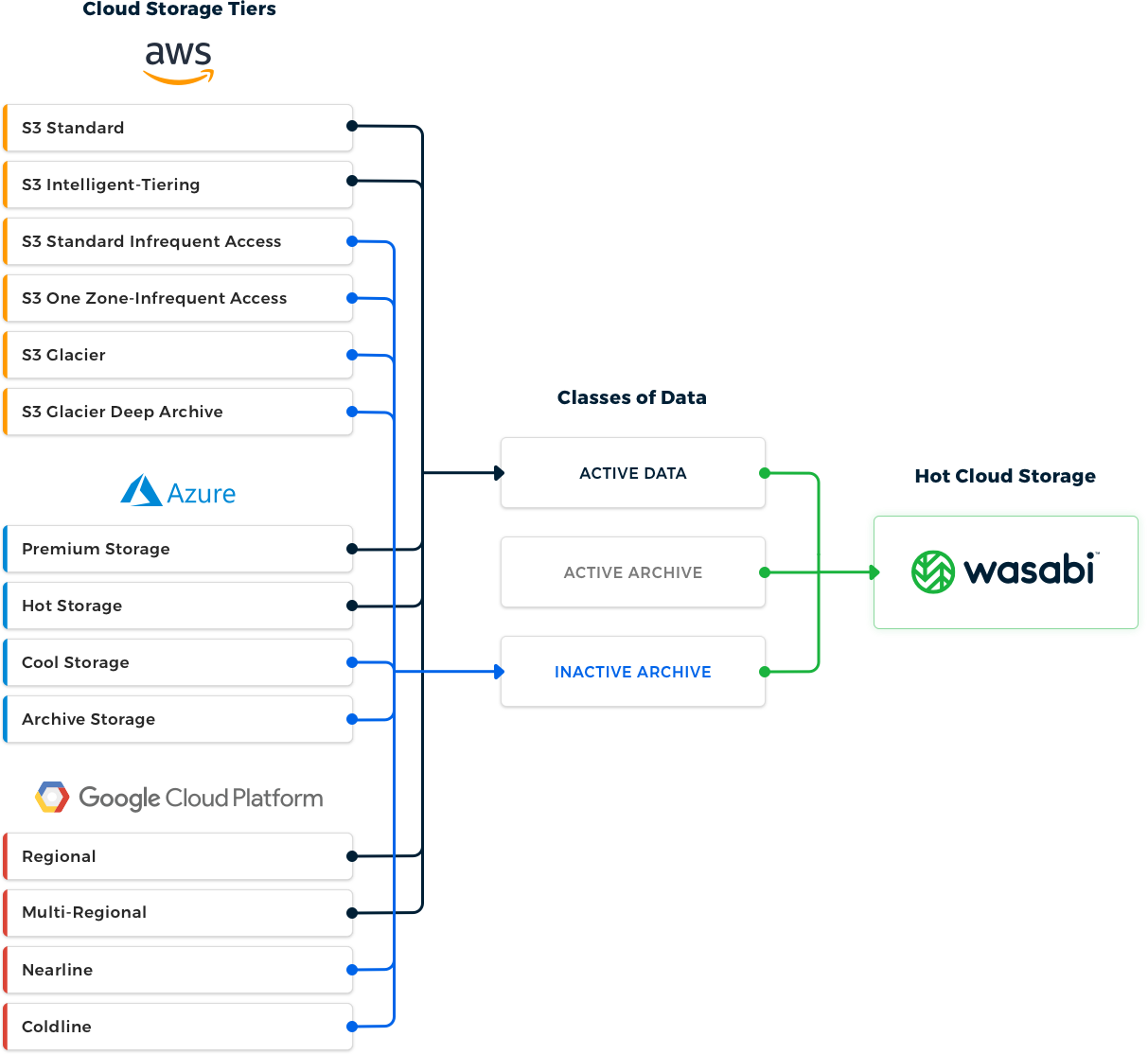
Image Credit: Wasabi Technologies
“In today’s digital-first world, data can be an organization’s greatest asset – empowering them with valuable insights that can transform business. Our collaboration with Wasabi technology will allow clients to re-imagine business processes enabled by data, while focusing on resiliency, performance, security and compliance. We are helping organizations across all industries, even those that are highly regulated, uncover game-changing insights from any environment, without sacrificing security,” said Howard Boville, Head of IBM Hybrid Cloud Platform. For more information about IBM Cloud Satellite visit: https://www.ibm.com/cloud/satellite.
……………………………………………………………………………………………………………………………………………………………………
“When customers think about hybrid, it’s about being able to move their workloads between on-premises and public cloud as well as between [different] cloud platforms,” said HPE’s Joseph Yang said in an interview with ZDNET.
Cloud and software vendors have taken various approaches to address this, such as running an on-premises stack in a public cloud, on a bare-metal environment. However, this locks customers into the software vendor’s infrastructure, and the cost of running bare-metal on a public cloud is high.
Solutions currently offered by cloud vendors to manage hybrid workloads often have limited capabilities and flexibility, compared to what enterprises are used to with their on-premises environment, Yang said.
About IBM:
IBM is a leading provider of global hybrid cloud and AI, with consulting expertise. IBM helps clients in more than 175 countries capitalize on insights from their data, streamline business processes, reduce costs and gain the competitive edge in their industries. More than 4,000 government and corporate entities in critical infrastructure areas such as financial services, telecommunications and healthcare rely on IBM’s hybrid cloud platform and Red Hat OpenShift to affect their digital transformations quickly, efficiently and securely. IBM’s breakthrough innovations in AI, quantum computing, industry-specific cloud solutions and consulting deliver open and flexible options to our clients. All of this is backed by IBM’s legendary commitment to trust, transparency, responsibility, inclusivity and service. Visit www.ibm.com for more information.
About Wasabi Technologies:
Wasabi provides simple and affordable hot cloud storage for businesses all over the world. It enables organizations to store and instantly access an unlimited amount of data with no complex tiers or egress or API fees, delivering predictable costs that save money and industry leading security and performance businesses can count on. Trusted by tens of thousands of customers worldwide, Wasabi has been recognized as one of technology’s fastest-growing and most visionary companies. Created by Carbonite co-founders and cloud storage pioneers David Friend and Jeff Flowers, Wasabi is a privately held company based in Boston. Wasabi is a Proud Partner of the Boston Red Sox, and the Official Cloud Storage Partner of Liverpool Football Club and the Boston Bruins.
References:
https://www.ibm.com/hybrid-cloud
https://www.zdnet.com/article/companies-struggling-to-manage-hybrid-cloud/
Paradise Mobile’s Open RAN 4G/5G core network to run on AWS cloud
Paradise Mobile, a new Mobile Network Operator (MNO) building a greenfield, cloud-native, Open RAN (oRAN) 4G/5G mobile network from the ground up in Bermuda, today announced the selection of Amazon Web Services, Inc. (AWS) as its preferred cloud provider to help build an Open RAN 4G/5G network and bring innovative services to Bermuda for the first time.
Paradise Mobile will leverage AWS for digital platform workloads, with agreements to roll out AWS edge services on island to host the wireless core and Open RAN DU and CU workloads. Paradise Mobile is also working to bring AWS services to the island, which will provide local businesses and innovators in the IoT industry the necessary tools and infrastructure to rapidly develop, test and deploy cutting edge products and services. The new environment will provide the ability for a secure, scalable, and high-performance network, optimized for businesses to develop and launch their next big thing.

Sam Tabbara, Co-Founder and CEO, Paradise Mobile, said: “We see Amazon as a strategic long-term collaborator who shares our vision and values, and has the ability to significantly accelerate our roadmap of innovative new products and services we want to launch in Bermuda. This relationship will allow us to provide our customers with the best possible experience and create a hub for IoT innovation in Bermuda and beyond.”
Tabbara said Paradise plans to run its 5G network operations – including management software from Mavenir – directly inside a Kubernetes stack running on AWS. To do so, Tabbara explained that Paradise will install an instance of AWS inside a LinkBermuda data center and will run AWS at the base of each of its roughly two dozen planned cell towers. “The opportunity for us with AWS is to accelerate that [5G] future,” Tabbara told Light Reading.
The new IoT environment will also provide businesses with access to a wide range of AWS services. These services will give businesses the ability to process and analyze vast amounts of data in real-time, enabling them to create new and innovative products and services.
Sameer Vuyyuru, head of worldwide business development at AWS, said: “Leveraging AWS helps reduce time-to-market as well as create a new path to deliver innovation to customers. Our work with Paradise Mobile will not only help Paradise Mobile rapidly build, scale, and manage its mobile network but also offer secure solutions to accelerate innovation across Bermuda.”
Paradise intends to build specific network-based applications and services that can be used by other operators. Drone operations is one of the first 5G use cases that Paradise plans to support. Tabbara said that the company is in discussions with an unnamed drone startup that may use the Paradise 5G network for testing.
AWS will play a key role in that strategy, according to Tabbara. He explained that enterprise developers are already familiar with AWS’ cloud computing platform and therefore will be able to add networking into the mix as Paradise lights up its 5G operations. “Anyone who knows how to code applications … if you are able to code within that [AWS] ecosystem, then there’s value add for us to be in that same ecosystem,” Tabbara said. The drone startup plans to do its development work inside the relatively familiar confines of Amazon’s cloud computing platform. “We’re already co-developing some of these solutions,” Tabbara said.
The announcement is yet another win for AWS as the hyperscaler competes against Oracle, Microsoft and Google Cloud for the telecom business. Omdia asked 49 telecom executives to list which public cloud or clouds their company is currently using to run any network functions, and respondents could select all that apply. Here was their response:
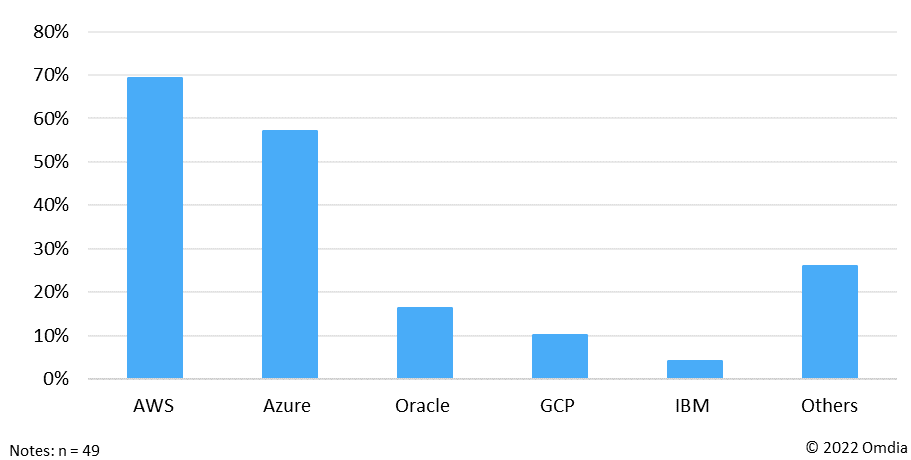
Note: Azure is Microsoft’s cloud offering, Google Cloud Platform is Google/Alphabet’s
…………………………………………………………………………………………………………………………………
Paradise Mobile is building a next generation wireless net network in Bermuda, followed by other CARICOM markets to be announced in the near future.
About Paradise Mobile:
Paradise Mobile is building a world of effortless connection with a next generation wireless network launching in multiple markets and countries, starting with Bermuda in 2023. Visit www.paradisemobile.com to learn more.
References:
China to introduce early 6G applications by 2025- way in advance of 3GPP specs & ITU-R standards
Liu said early 6G “application scenarios” will be introduced by 2025 in China, home to the world’s largest internet user population and biggest smartphone market, which has been conducting research and development on the technology since 2019. He said the commercial launch of 6G in China is expected to start from 2030, according to a report by local media National Business Daily.
At the same event, China’s Minister of Industry and Information Technology Jin Zhuanglong said in his speech that China was leading the pace of 6G research and development worldwide. He said the country is already ahead in rolling out 5G mobile networks and applications.

The statements made at the CDF about China’s 6G efforts have come after the Global 6G Conference, held from March 22 to 24 in Nanjing, where telecommunications industry experts reached a consensus that 6G mobile services in the country will start to roll out by early 2030.
The country’s three telecoms network operators – China Mobile, China Telecom and China Unicom – have all been reported to be involved in early 6G research and development, as they also expedited the roll-out of 5G infrastructure and services across the country.
Tensions between Beijing and Washington, however, have led to major telecoms equipment suppliers Huawei Technologies Co and ZTE Corp being handicapped by various US sanctions, including access to advanced IC’s used in smartphones and networking gear.
In spite of the disruptions caused by US pressure and the coronavirus pandemic, China has already built the world’s largest 5G mobile network, with more than 2.31 million 5G base stations deployed at the end of last year, according to MIIT data.
This year will mark the beginning of a long journey for 6G, as new studies are initiated by more countries and organisations around the world, according to a report last month by the non-profit telecoms industry body the GSMA.
The ITU-R World Radiocommunication Conference in November (WRC 23) is expected to set the spectrum foundations for 6G, the GSMA report said. Spectrum refers to the radio frequencies allocated to the mobile industry and other sectors for communications over the airwaves.
References:
China’s MIIT to prioritize 6G project, accelerate 5G and gigabit optical network deployments in 2023
China Mobile unveils 6G architecture with a digital twin network (DTN) concept
India unveils Bharat 6G vision document, launches 6G research and development testbed
NTT DOCOMO & SK Telecom Release White Papers on Energy Efficient 5G Mobile Networks and 6G Requirements
Summary of ITU-R Workshop on “IMT for 2030 and beyond” (aka “6G”)
SEACOM telecom services now on Equiano subsea cable surrounding Africa
SEACOM, Africa’s leading telecommunications and managed services provider, announced that it has launched its services on the Equiano subsea cable, which landed in Cape Town, South Africa, in August 2022. As a result, the company now provides Private Line services, with an impressive latency speed of approximately 110 milliseconds (ms) between South Africa and Europe, making it the fastest direct route between the two continents.
The cable now forms part of SEACOM’s subsea cable ecosystem surrounding Africa, supported by a continent-wide IP-MPLS network. SEACOM fulfilled the necessary equipment and installation requirements with the help of its technology partner, Infinera.
Google announced the Equiano subsea cable in 2019, which is among Africa’s most high-capacity cables. The cable spans 15,000 kilometers from Portugal to South Africa, has twelve fibre pairs, and has a design capacity of 144 Tbps. The cable has a landing station in Melkbosstrand, Cape Town, as well as in other African locations, including Rupert’s Bay, St. Helena; Lome, Togo; Lagos, Nigeria; and Swakopmund, Namibia. Branching units from these stations will further extend connectivity to other African countries.
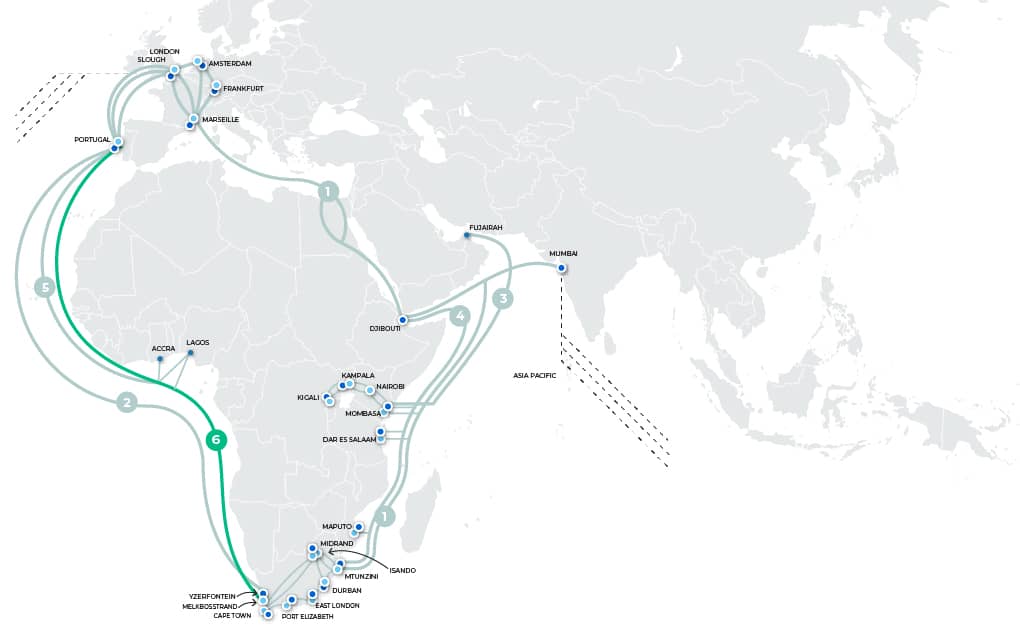
SEACOM’s Subsea Cable Ecosystem, Image courtesy: SEACOM
The company said, “The launch comes after SEACOM has completed extensive work to support the new connection, including upgrades to its transmission and IP network both locally and internationally. As part of the service available to wholesale and enterprise clients from March, SEACOM will offer an express route from Cape Town to Lisbon. This means clients will enjoy high-speed connectivity without having their data rerouted to other countries during transmission.”
“This launch results from years of project negotiations and planning, driven by a goal to be ready to offer quality service to our customers from day one. The Equiano subsea cable represents a new stage in Africa’s digital transformation, meeting Africa’s growing data requirements, enabling cross-border digital trade, and offering citizens and enterprises new opportunities,” says Prenesh Padayachee, SEACOM’s Group Chief Digital Officer.
“Infinera is delighted to partner with SEACOM to light the Equiano subsea cable with our industry-leading ICE6 800G technology,” said Nick Walden, Infinera Senior Vice President, Worldwide Sales. “With the industry’s highest spectral efficiency, ICE6 enables SEACOM to maximise the number of high-speed services they can offer, providing multiple terabits of capacity on this critical subsea link.”
According to a Regional Economic Impact Assessment by Africa Practice, commissioned by Google and published in 2021, the cable will increase South Africa’s GDP by USD 5.8 billion and create 180,000 indirect jobs by 2025.
SEACOM has acquired a full fiber pair with a capacity of 12 Tbps on the Express Route, which results in reduced latency between Africa and Europe. As a result, the SEACOM Express Route provides the quickest and most direct path between Africa and Europe, with the lowest possible latency. This route enables Operators, ISPs, Telcos, Content Providers, and Enterprises with the fastest direct path between Africa and Europe with the lowest latency, connecting to key South African and European data centers.
References:
https://seacom.com/media-centre/seacom-goes-live-on-equiano-subsea-cable/
https://telecomtalk.info/seacom-services-now-live-equiano-subsea-cable/689226/




